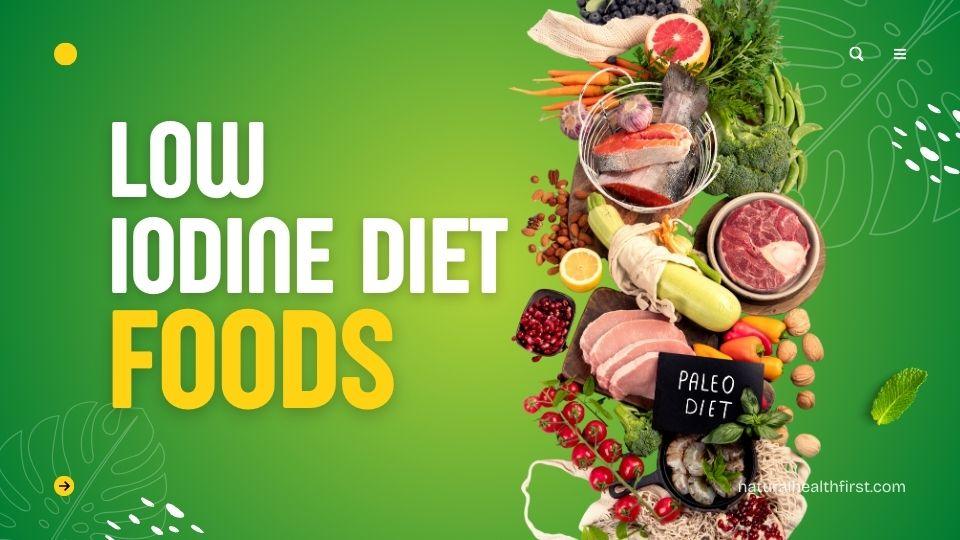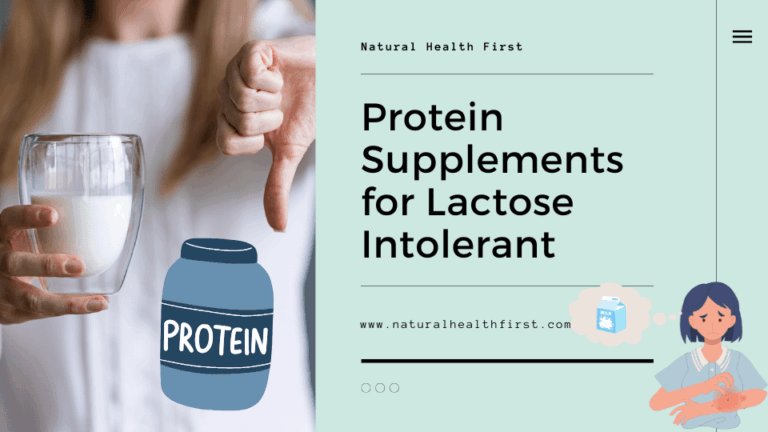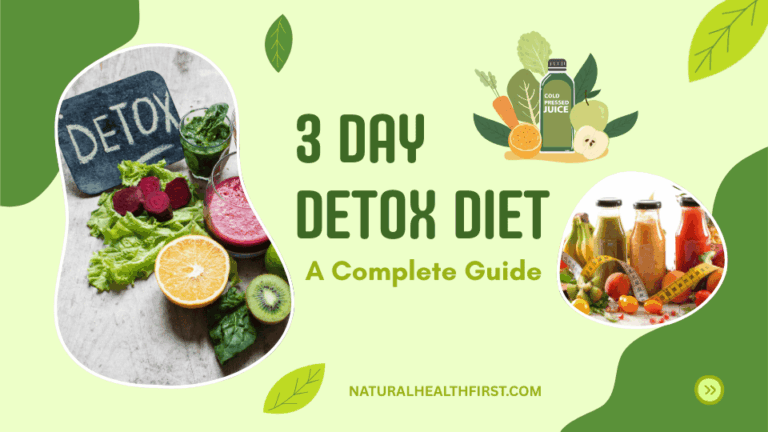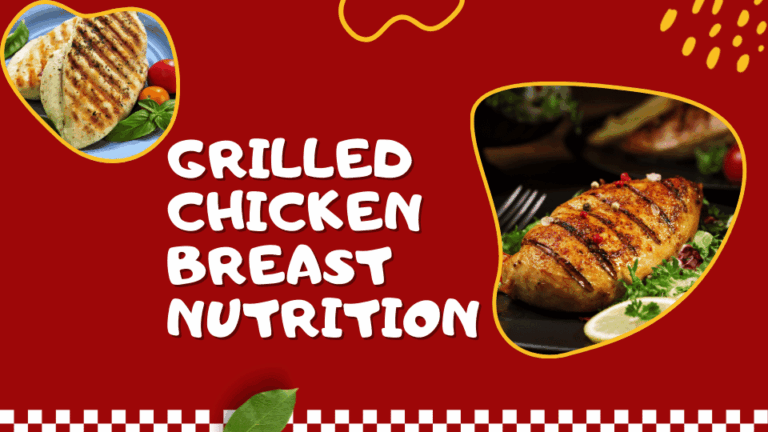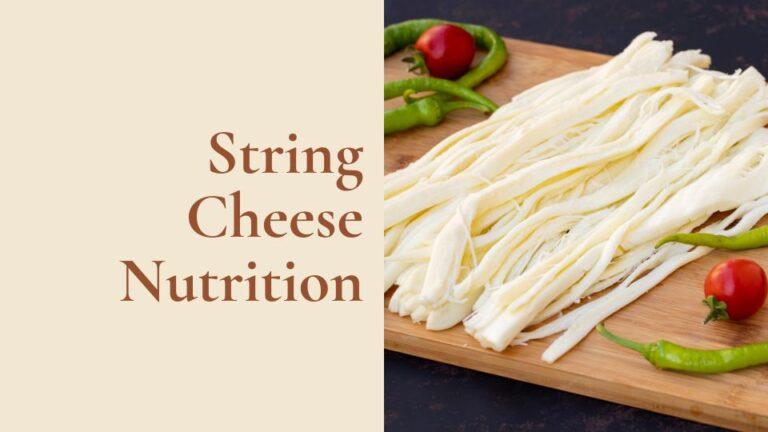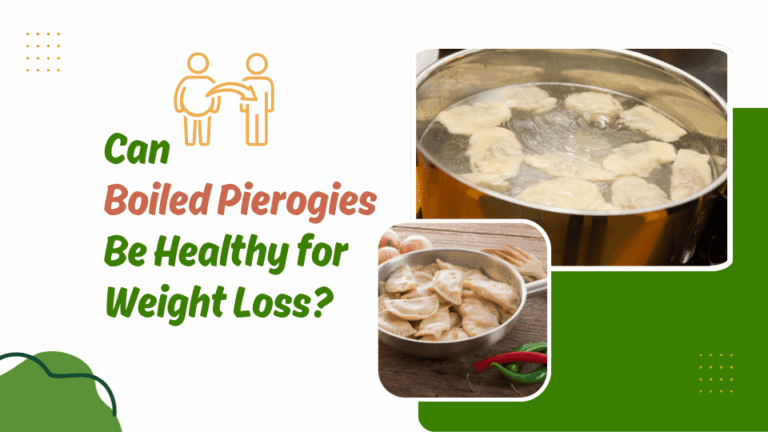As a naturopathic physician specializing in thyroid health, I frequently guide patients through the challenging yet crucial process of following a low iodine diet. This specialized dietary approach plays a vital role in preparing for radioactive iodine therapy and managing certain thyroid conditions. Understanding which foods to embrace and which to avoid can make the difference between successful treatment outcomes and unnecessary complications.
The low iodine diet represents more than just dietary restriction—it’s a therapeutic tool that temporarily depletes the body’s iodine stores, making thyroid tissue more receptive to radioactive iodine treatment. While the process may seem daunting initially, proper planning and understanding of approved foods can make this journey both manageable and nutritionally adequate.
This comprehensive guide will walk you through everything you need to know about low iodine diet foods, from understanding the basic principles to creating satisfying meal plans that support your healing process while maintaining optimal nutrition during this critical period.
Also Read: 10 Protein Supplements for Lactose Intolerant
About Low Iodine Diet
The low iodine diet serves a specific medical purpose by reducing dietary iodine intake to less than 50 micrograms per day. This dramatic reduction depletes the body’s iodine stores, creating an “iodine-hungry” state that enhances the effectiveness of radioactive iodine therapy for thyroid cancer patients.
Under normal circumstances, the average American consumes 200-400 micrograms of iodine daily through iodized salt, processed foods, and naturally iodine-rich ingredients. The low iodine diet essentially reverses this pattern, requiring careful attention to food choices and preparation methods.
The diet’s effectiveness depends on strict adherence to guidelines, as even small amounts of excess iodine can interfere with treatment outcomes. This temporary dietary modification typically lasts 1-4 weeks, depending on your specific treatment protocol and physician recommendations.
What Is a Low Iodine Diet?
A low iodine diet limits foods rich in iodine, typically restricting daily intake to less than 50 micrograms per day. It’s not a permanent lifestyle, but rather a short-term preparation for thyroid-related treatments. The diet generally lasts 1–2 weeks before radioactive iodine therapy and sometimes for a few days after.
The main goal is to deplete the thyroid gland of iodine so it will absorb radioactive iodine more effectively during treatment.
Why Is a Low Iodine Diet Important?
- Enhances treatment outcomes – It improves the effectiveness of radioactive iodine therapy for thyroid cancer.
- Supports thyroid testing – It ensures more accurate diagnostic scans.
- Helps identify triggers – Following the diet can help people notice how iodine-rich foods affect their thyroid.
Low Iodine Diet Foods: What You Can Eat
Choosing the right low iodine diet foods can be confusing, but here’s a detailed breakdown of safe choices:
✅ Safe Foods (Low Iodine Approved)
- Fruits: Apples, pears, bananas, grapes, melons, peaches, plums, berries (avoid canned in heavy syrup).
- Vegetables: Fresh or frozen peas, carrots, potatoes, cucumbers, zucchini, onions, spinach, kale (avoid seaweed or kelp).
- Grains: White rice, oatmeal, unsalted popcorn, pasta, unsalted crackers, homemade bread without iodized salt.
- Proteins: Fresh chicken, turkey, beef, lamb, and unsalted nuts (avoid processed meats).
- Dairy Alternatives: Almond milk, oat milk, coconut milk (ensure iodine-free).
- Seasonings: Fresh herbs, black pepper, garlic, onion powder, homemade spice blends without iodized salt.
- Oils & Fats: Olive oil, coconut oil, sunflower oil, avocado oil.
- Snacks: Unsalted chips, pretzels without iodized salt, fruit smoothies, homemade granola.
Low Iodine Diet for Thyroid Cancer
Thyroid cancer patients preparing for radioactive iodine therapy must follow this specialized diet to optimize treatment effectiveness. The diet works by depleting normal thyroid tissue and any remaining cancer cells of iodine, making them more likely to absorb the therapeutic radioactive iodine.
Research demonstrates that patients who strictly follow the low iodine diet before RAI therapy show significantly better treatment outcomes. The depleted iodine state forces both normal and cancerous thyroid cells to actively uptake the radioactive iodine, concentrating the therapeutic radiation where it’s needed most.
The timing of diet implementation varies among treatment centers, but most oncologists recommend starting the low iodine diet 1-2 weeks before radioactive iodine administration. Some patients may need to continue the diet for several days after treatment, depending on their specific protocol.
Working closely with your healthcare team ensures proper timing and adherence to guidelines specific to your treatment plan. Never attempt to modify the diet duration or strictness without medical supervision, as this could compromise treatment effectiveness.
Preparing for RAI Therapy Low Iodine Diet
The preparation phase for radioactive iodine therapy requires meticulous planning and commitment to dietary restrictions. Success depends on understanding both the scientific rationale and practical implementation of the low iodine diet.
Begin planning your low iodine diet at least two weeks before starting the actual restrictions. This preparation time allows you to shop for appropriate ingredients, learn new cooking techniques, and mentally prepare for the dietary changes ahead.
Key preparation steps include:
- Menu planning and recipe research – Identify 7-10 go-to meals that meet low iodine requirements
- Pantry cleanup – Remove or clearly label high-iodine foods to avoid accidental consumption
- Shopping for specialty ingredients – Stock up on non-iodized salt, fresh herbs, and approved condiments
- Kitchen equipment preparation – Ensure you have adequate storage containers for homemade foods
- Family communication – Educate household members about your dietary restrictions to prevent cross-contamination
Consider this preparation period as an investment in your treatment success. The more thoroughly you prepare, the easier the actual diet implementation becomes.
Low Iodine Diet Guidelines and Restrictions
Understanding the fundamental principles behind low iodine diet restrictions helps you make informed food choices throughout the diet period. The guidelines may initially seem overwhelming, but they follow logical patterns once you understand the underlying reasons.
Primary Restriction Categories
Iodized salt and sea salt contain high levels of iodine and must be completely eliminated. This includes any foods prepared with these salts, which encompasses most processed and restaurant foods.
Dairy products are restricted because iodine-containing sanitizers used in dairy processing and iodine supplements given to dairy cows result in high iodine content in milk, cheese, yogurt, and other dairy products.
Seafood and seaweed naturally concentrate iodine from ocean water, making all fish, shellfish, and sea vegetables off-limits during the diet period.
Commercial baked goods typically contain iodinated dough conditioners and are prepared with iodized salt, requiring complete avoidance of store-bought breads, pastries, and baked items.
How Strict Is a Low Iodine Diet
The low iodine diet requires absolute adherence to be effective for medical treatment. Unlike some dietary modifications that allow occasional flexibility, this therapeutic diet demands 100% compliance to achieve the desired iodine depletion.
Even small amounts of iodine—as little as 50-100 micrograms from a single high-iodine meal—can interfere with treatment effectiveness. This means reading every ingredient label, avoiding cross-contamination, and preparing most foods from scratch using approved ingredients.
The strictness extends beyond obvious high-iodine foods to include seemingly innocent items like vitamins containing iodine, certain medications, and topical antiseptics. Always consult with your healthcare team before consuming anything you’re uncertain about.
This level of restriction may feel overwhelming, but remember it’s temporary and serves a crucial medical purpose. The short-term inconvenience pales in comparison to the potential impact on your treatment outcomes and long-term health.
What to Eat on a Low Iodine Diet
Despite the extensive restrictions, numerous delicious and nutritious foods remain available on the low iodine diet. Focusing on approved foods rather than restrictions helps maintain a positive mindset and ensures adequate nutrition during this challenging period.
Fresh Fruits and Vegetables
Most fresh fruits and vegetables contain minimal iodine and form the foundation of a healthy low iodine diet. These nutrient-dense foods provide essential vitamins, minerals, and antioxidants while offering variety and flavor to your meals.
Approved fruits include:
- Apples, pears, and stone fruits (peaches, plums, apricots)
- Berries of all types (strawberries, blueberries, raspberries)
- Citrus fruits (oranges, lemons, limes, grapefruits)
- Bananas and other tropical fruits (pineapple, mango, papaya)
- Melons and grapes
Approved vegetables include:
- Leafy greens (lettuce, spinach, arugula, kale)
- Cruciferous vegetables (broccoli, cauliflower, cabbage)
- Root vegetables (carrots, beets, sweet potatoes, regular potatoes)
- Squashes and zucchini
- Tomatoes, peppers, and eggplant
- Green beans, peas, and corn
Protein Sources
Finding adequate protein on a low iodine diet requires creativity since seafood and many processed meats are prohibited. Focus on fresh, unprocessed protein sources prepared with approved seasonings.
Approved protein sources:
- Fresh poultry (chicken, turkey, duck) without injected broth or seasonings
- Fresh red meat (beef, pork, lamb) in moderation
- Eggs (limit to 5 per week due to naturally occurring iodine in egg yolks)
- Dried beans, lentils, and legumes
- Nuts and seeds (except those processed with salt)
- Nut butters without added salt
When purchasing meat and poultry, avoid products that have been injected with broth, contain added sodium, or include seasoning packets. Fresh, unseasoned proteins provide the safest options for maintaining dietary compliance.
Grains and Starches
Most plain grains and starches work well on the low iodine diet, providing essential carbohydrates and helping create satisfying meals. The key is avoiding processed versions that may contain iodized salt or other restricted ingredients.
Approved grain options:
- Plain rice (white, brown, wild varieties)
- Quinoa and other ancient grains
- Oats and oatmeal (not instant varieties with salt)
- Plain pasta made without eggs
- Homemade bread using non-iodized salt
- Plain cereals without added vitamins or minerals
Prepare these foods with approved seasonings and fats to enhance flavor while maintaining compliance with diet restrictions.
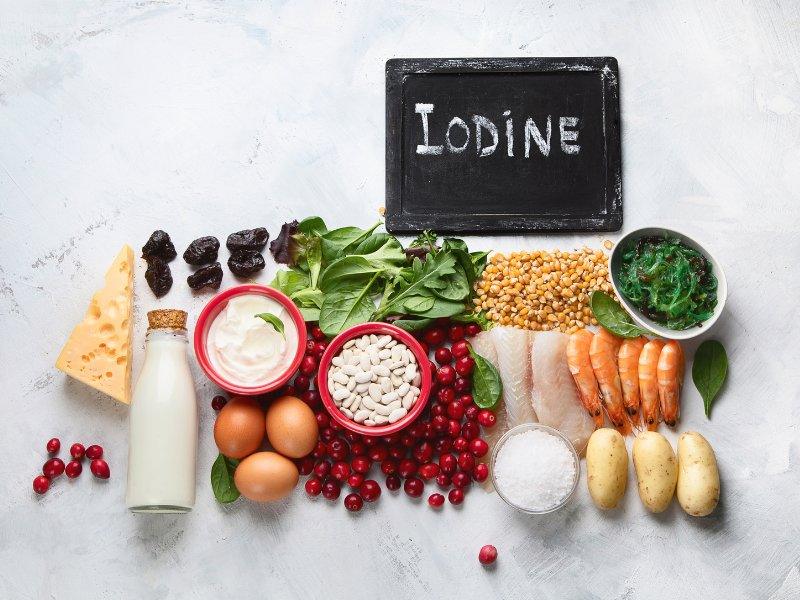
Foods to Avoid on a Low Iodine Diet
Understanding which foods to completely avoid prevents accidental consumption of high-iodine ingredients that could compromise your treatment. This comprehensive avoid list covers obvious and hidden sources of dietary iodine.
| Food Category | Avoid These Foods |
|---|---|
| Salt | Iodized salt, sea salt, kosher salt with iodine |
| Seafood | Fish, shellfish, seaweed, kelp supplements |
| Dairy | Milk, cheese, butter, cream, ice cream, yogurt |
| Egg Products | Egg yolks (egg whites are fine) |
| Processed Foods | Packaged soups, canned foods with salt, fast food |
| Baked Goods | Store-bought bread, cakes, cookies made with iodized salt |
| Food Colorants | Red Dye #3 and some artificial coloring |
| Soy Products | Soy milk, tofu, soy sauce, miso, tempeh |
High-Iodine Natural Foods
All seafood and sea vegetables must be eliminated completely. This includes fresh fish, canned fish, shellfish, sushi, seaweed snacks, and any supplements containing sea-based ingredients.
Dairy products in all forms are prohibited, including milk, cheese, yogurt, ice cream, butter, and any foods containing dairy ingredients. This restriction often surprises patients, but dairy represents one of the highest dietary iodine sources.
Egg yolks contain naturally occurring iodine, though egg whites are generally acceptable in limited quantities. Most practitioners recommend limiting whole eggs to 5 per week maximum.
Processed Foods and Additives
Commercial baked goods contain iodinated dough conditioners and iodized salt, making all store-bought breads, pastries, crackers, and baked items off-limits.
Processed meats like deli meats, hot dogs, bacon, and sausages typically contain iodized salt and other restricted additives. Always choose fresh, unprocessed meats instead.
Restaurant foods present significant challenges since most are prepared with iodized salt and may contain other restricted ingredients. Avoid restaurant meals entirely during the diet period.
Packaged snacks almost universally contain iodized salt or other prohibited ingredients. Read labels carefully, but generally avoid all commercially packaged snack foods.
Hidden Iodine Sources
Vitamins and supplements often contain iodine, even when not prominently listed. Check all supplements with your healthcare provider before continuing use during the diet.
Medications may contain iodine-based ingredients or dyes. Review all prescriptions and over-the-counter medications with your physician or pharmacist.
Topical antiseptics containing iodine can be absorbed through the skin. Avoid iodine-based antiseptics and wound care products during the diet period.
Must Read: Can Boiled Pierogies Be Healthy for Weight Loss?
Low Iodine Diet Plan and Sample Menu
Creating a structured meal plan helps ensure nutritional adequacy while maintaining strict adherence to low iodine guidelines. This sample plan demonstrates how to create satisfying, varied meals within the dietary restrictions.
Day 1 Sample Menu
Breakfast:
- Homemade oatmeal with sliced banana and cinnamon
- Fresh orange juice
- Black coffee or herbal tea
Lunch:
- Grilled chicken breast with herbs and non-iodized salt
- Steamed broccoli with lemon juice
- Brown rice pilaf with vegetables
- Fresh fruit salad
Dinner:
- Baked sweet potato stuffed with black beans
- Mixed green salad with olive oil and vinegar dressing
- Sautéed spinach with garlic
- Fresh berries for dessert
Snacks:
- Apple slices with unsalted almond butter
- Homemade trail mix (unsalted nuts and dried fruit)
Day 2 Sample Menu
Breakfast:
- Fresh fruit smoothie (banana, berries, orange juice)
- Homemade toast with jam
- Herbal tea
Lunch:
- Turkey and avocado sandwich on homemade bread
- Carrot and celery sticks
- Homemade vegetable soup
- Fresh pear
Dinner:
- Beef stir-fry with vegetables and brown rice
- Steamed green beans
- Side salad with approved dressing
- Homemade fruit sorbet
Weekly Planning Strategy
Plan your meals around approved proteins, building each meal with complementary vegetables and grains. Batch cooking on weekends helps ensure you always have compliant meals available during busy weekdays.
Prepare large quantities of approved basics like rice, quinoa, and homemade bread that can be used throughout the week. Having these staples ready makes daily meal preparation much more manageable.
Low Iodine Diet Recipes and Meal Ideas
Developing a repertoire of go-to recipes makes the low iodine diet more enjoyable and sustainable. These recipe ideas demonstrate how to create flavorful, satisfying meals within the dietary restrictions.
Breakfast Ideas
Homemade Pancakes Combine approved flour, baking powder (aluminum-free), non-iodized salt, and plant milk alternative. Cook with approved oil and serve with fresh fruit and pure maple syrup.
Breakfast Rice Bowl Cook brown rice with cinnamon and serve topped with sliced banana, chopped walnuts, and a drizzle of honey. Add fresh berries for extra antioxidants and flavor.
Veggie Scramble Sauté approved vegetables in olive oil, add beaten egg whites, and season with herbs and non-iodized salt. Serve with homemade toast and fresh fruit.
Lunch and Dinner Options
Mediterranean Chicken Marinate chicken breasts in olive oil, lemon juice, garlic, and herbs. Grill and serve over rice with roasted vegetables and a simple salad.
Bean and Vegetable Curry Sauté onions, garlic, and approved spices in coconut oil. Add coconut milk, vegetables, and cooked lentils or chickpeas. Serve over rice or quinoa.
Stuffed Bell Peppers Fill bell peppers with a mixture of ground turkey, rice, vegetables, and herbs. Bake until peppers are tender and filling is heated through.
Snack and Dessert Ideas
Homemade Trail Mix Combine unsalted nuts, seeds, and dried fruit for a portable, nutritious snack that satisfies between meals.
Fresh Fruit Sorbet Blend frozen fruit with a small amount of fruit juice and freeze until set. This refreshing dessert satisfies sweet cravings without restricted ingredients.
Vegetable Chips Thinly slice sweet potatoes, beets, or other approved vegetables. Toss with olive oil and approved seasonings, then bake until crispy.
LOW IODINE DIET SAMPLE MENU ITEMS
BREAKFAST
- Any fruit or fruit juices
- Eggbeaters
- Oatmeal with toppings – cinnamon, honey, applesauce, maple syrup, walnuts, fruit
- 1 slice toast
- Black coffee or tea
LUNCH
- Vegetarian or chicken with rice soup
- Matzo crackers
- White or brown rice with vegetable plate (fresh or frozen)
- Salad – fruit or vegetable – oil and vinegar dressing
- Fruits – fresh, frozen or canned
- Black coffee or tea
DINNER
- 6 oz Roast beef, lamb, veal, pork, soup or turkey
- Potato – baked or broiled
- Vegetables (fresh or frozen)
- Salad – fruit or vegetable – oil and vinegar dressing
- Fruits
- Black coffee or tea
SNACKS
- Fresh fruit or juice
- Dried fruits such as raisins
- Fresh raw vegetables
- Applesauce
- Unsalted nuts
- Fruit juice
- Unsalted peanut butter (great with apple slices, carrot sticks, crackers
or rice cakes) - Matzoh and other unsalted crackers
- Home-made bread and muffins
Low Iodine Diet Duration and Timeline
The duration of the low iodine diet varies depending on your specific treatment protocol and medical condition. Understanding the typical timeline helps you prepare mentally and practically for the diet period.
Pre-Treatment Phase
Most patients follow the low iodine diet for 1-2 weeks before radioactive iodine therapy. Some treatment centers recommend 3-4 weeks for optimal iodine depletion, particularly for patients with higher baseline iodine intake.
During this phase, focus on strict adherence to guidelines while maintaining adequate nutrition and energy levels. The body typically adapts to the dietary changes within the first week, making the second week more manageable.
Treatment and Post-Treatment
Continue the low iodine diet through your radioactive iodine treatment and typically for 24-48 hours afterward, depending on your physician’s recommendations. Some patients may need to extend the diet slightly longer based on their treatment response.
The post-treatment period often feels like the most challenging time since you’re eager to resume normal eating. However, completing the full recommended duration ensures optimal treatment effectiveness.
Gradual Reintroduction
When cleared by your healthcare team, gradually reintroduce restricted foods rather than immediately returning to your previous diet. This approach helps prevent digestive upset and allows you to mindfully reestablish healthy eating patterns.
Start with small amounts of previously restricted foods, paying attention to how your body responds. Some patients find they feel better continuing with reduced processed food intake even after completing the medical necessity for the low iodine diet.
Low Iodine Diet Benefits and Risks
While the low iodine diet serves a crucial medical purpose, understanding both benefits and potential risks helps you navigate the diet period safely and effectively.
Medical Benefits
The primary benefit is enhanced effectiveness of radioactive iodine therapy for thyroid cancer treatment. Studies consistently show better treatment outcomes when patients strictly adhere to pre-treatment low iodine diets.
Some patients also report improved awareness of processed food consumption and develop better cooking skills during the diet period. This increased mindfulness about food choices often leads to lasting positive dietary changes.
The temporary nature of the diet means any nutritional concerns are short-term, and most patients can maintain adequate nutrition with proper planning and attention to approved foods.
Potential Risks and Mitigation
Nutritional deficiencies can develop if the diet is followed for extended periods or without adequate variety in approved foods. Focus on consuming a wide range of fruits, vegetables, and approved protein sources to maintain nutritional balance.
Social isolation may occur due to inability to eat restaurant meals or participate in normal social dining activities. Plan ahead for social situations and communicate your dietary needs clearly to friends and family.
Psychological stress from the restrictive nature of the diet is common and normal. Remember that this is temporary and serves an important medical purpose. Seek support from your healthcare team if stress becomes overwhelming.
Low Iodine Diet Tips for Success
Practical strategies can make the difference between struggling through the diet period and managing it successfully while maintaining your quality of life and treatment compliance.
Meal Preparation Strategies
Batch cooking saves time and ensures compliant meals are always available. Dedicate time on weekends to prepare large quantities of approved staples like grains, roasted vegetables, and cooked proteins.
Label everything clearly to prevent accidental consumption of restricted foods. Use bright labels or separate storage containers for approved foods to avoid confusion, especially if family members aren’t following the same restrictions.
Keep emergency snacks available at all times. Pack approved snacks when leaving home to avoid temptation or desperate food choices when hungry and away from home.
Shopping and Storage
Read every label carefully, even on foods you think are safe. Manufacturers change formulations frequently, and seemingly innocent products may contain restricted ingredients.
Shop the perimeter of grocery stores where fresh, unprocessed foods are typically located. The center aisles contain mostly processed foods that are likely to be off-limits.
Buy in bulk for frequently used items like non-iodized salt, approved grains, and frozen fruits and vegetables. Having adequate supplies prevents the stress of running out of compliant foods.
Managing Social Situations
Communicate clearly with friends, family, and coworkers about your dietary restrictions. Most people are understanding and willing to accommodate when they understand the medical necessity.
Offer to bring dishes to social gatherings that you know are compliant. This ensures you have something safe to eat while contributing to the event.
Plan restaurant alternatives like picnics or home gatherings where you have more control over food preparation and ingredients.
Low Iodine Diet for Hyperthyroidism
While less common than its use in thyroid cancer treatment, the low iodine diet sometimes supports hyperthyroidism management, particularly before certain treatments or diagnostic procedures.
Hyperthyroid patients may need to follow low iodine guidelines before radioactive iodine therapy aimed at reducing thyroid function rather than treating cancer. The same principles apply, but the duration and strictness may vary based on the specific treatment goals.
Work closely with your endocrinologist to understand exactly how the low iodine diet fits into your overall treatment plan for hyperthyroidism. The diet requirements may differ slightly from those used in cancer treatment protocols.
Some patients with hyperthyroidism find that reducing dietary iodine helps manage symptoms even outside of formal treatment periods. However, never attempt to self-treat hyperthyroidism with dietary modifications alone—this condition requires proper medical management.
Nutritional Considerations and Supplements
Maintaining adequate nutrition during the low iodine diet requires attention to potential gaps created by eliminating major food groups like dairy and seafood.
Calcium intake may be reduced due to dairy restrictions. Focus on approved calcium sources like leafy green vegetables, broccoli, and fortified plant-based milk alternatives (check labels for iodine content).
Protein quality remains high if you include a variety of approved protein sources. Combine different plant proteins throughout the day to ensure complete amino acid profiles.
B-vitamin intake particularly B12, may be affected if you typically rely on dairy products and seafood for these nutrients. Discuss appropriate supplementation with your healthcare provider.
Vitamin D levels should be monitored, especially if the diet coincides with limited sun exposure or if you previously relied on fortified dairy products for vitamin D intake.
Most standard multivitamins contain iodine and should be avoided during the diet period. Work with your healthcare team to identify specific supplements that are both safe and necessary for your individual situation.
Conclusion and Long-Term Considerations
Successfully completing a low iodine diet requires preparation, commitment, and support from your healthcare team and loved ones. While challenging, this temporary dietary modification plays a crucial role in optimizing treatment outcomes for thyroid conditions.
Remember that this is a temporary intervention serving a specific medical purpose. The restrictions are not meant to be permanent, and you will be able to return to a normal, varied diet once your treatment is complete.
Stay in close communication with your healthcare team throughout the diet period, and don’t hesitate to ask questions or seek support when needed. Your commitment to following these guidelines carefully contributes significantly to your treatment success and overall health outcomes.
The low iodine diet represents an investment in your health and recovery. By approaching it with knowledge, preparation, and a positive attitude, you can successfully navigate this challenging but important aspect of your thyroid treatment journey.

